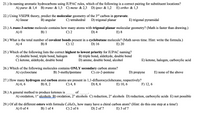
Chemistry
10th Edition
ISBN: 9781305957404
Author: Steven S. Zumdahl, Susan A. Zumdahl, Donald J. DeCoste
Publisher: Cengage Learning
expand_more
expand_more
format_list_bulleted
Question
question 23

Transcribed Image Text:21.) In naming aromatic hydrocarbons using IUPAC rules, which of the following is a correct pairing for substituent locations?
D) ipso- & 1,2
А) рara- & 1,4 B) trans- & 1,3 C) тeta- & 2,3
E) ortho- & 1,3
22.) Using VSEPR theory, predict the molecular geometry of the 3rd carbon in pyruvate.
A) linear
B) angular
C) tetrahedral
D) trigonal planar
E) trigonal pyramidal
23.) A trans-3-octene molecule contains how many atoms with trigonal planar molecular geometry? (Math is faster than drawing.)
D) 4
A) 0
В) 1
C) 2
E) 8
24.) What is the total number of covalent bonds present in a cyclobutane molecule? (Math saves time. Hint: write the formula.)
D) 16
A) 4
В) 8
C) 12
E) 20
25.) Which of the following lists the correct highest to lowest priority for IUPAC naming?
B) triple bond, aldehyde, double bond
D) amine, double bond, alcohol
A) double bond, triple bond, halogen
C) ketone, aldehyde, double bond
E) ketone, halogen, carboxylic acid
26.) Which of the following molecules contains ONLY secondary carbon atoms?
B) 3-methylpentane
A) cyclooctane
C) cis-2-pentene
D) propyne
E) none of the above
27.) How many hydrogen and carbon atoms are present in 1,1-difluorocyclohexane, respectively?
C) 4, 8
A) 6, 6
В) 8, 2
D) 8, 6
E) 10, 6
F) 12, 6
28.) A general method to produce ketones is
of
A) oxidation, 1° alcohols B) oxidation, 2° alcohols C) reduction, 2° alcohols D) reduction, carboxylic acids E) not possible
29.) Of all the different esters with formula C4H§O2, how many have a chiral carbon atom? (Hint: do this one step at a time!)
D) 2 of 7
A) 0 of 4
В) 1 of 4
C) 2 of 6
E) 3 of 7
Expert Solution
This question has been solved!
Explore an expertly crafted, step-by-step solution for a thorough understanding of key concepts.
Step by stepSolved in 2 steps with 2 images

Knowledge Booster
Learn more about
Need a deep-dive on the concept behind this application? Look no further. Learn more about this topic, chemistry and related others by exploring similar questions and additional content below.Similar questions
- Select the Heterogeneous mixture from the list.a) A bar of Gold b) Cement with gravel c) Ammonia d) Nacho Cheese e) c and darrow_forward[answer with correct answer] Water exists as a solid (ice), a liquid and a gas (steam). Which state of matter will water be when it is easiest to compress?arrow_forwardQuestion 2. Chemicals make up everything around you, including your own body. A) True B) Falsearrow_forward
arrow_back_ios
arrow_forward_ios
Recommended textbooks for you
 ChemistryChemistryISBN:9781305957404Author:Steven S. Zumdahl, Susan A. Zumdahl, Donald J. DeCostePublisher:Cengage Learning
ChemistryChemistryISBN:9781305957404Author:Steven S. Zumdahl, Susan A. Zumdahl, Donald J. DeCostePublisher:Cengage Learning ChemistryChemistryISBN:9781259911156Author:Raymond Chang Dr., Jason Overby ProfessorPublisher:McGraw-Hill Education
ChemistryChemistryISBN:9781259911156Author:Raymond Chang Dr., Jason Overby ProfessorPublisher:McGraw-Hill Education Principles of Instrumental AnalysisChemistryISBN:9781305577213Author:Douglas A. Skoog, F. James Holler, Stanley R. CrouchPublisher:Cengage Learning
Principles of Instrumental AnalysisChemistryISBN:9781305577213Author:Douglas A. Skoog, F. James Holler, Stanley R. CrouchPublisher:Cengage Learning Organic ChemistryChemistryISBN:9780078021558Author:Janice Gorzynski Smith Dr.Publisher:McGraw-Hill Education
Organic ChemistryChemistryISBN:9780078021558Author:Janice Gorzynski Smith Dr.Publisher:McGraw-Hill Education Chemistry: Principles and ReactionsChemistryISBN:9781305079373Author:William L. Masterton, Cecile N. HurleyPublisher:Cengage Learning
Chemistry: Principles and ReactionsChemistryISBN:9781305079373Author:William L. Masterton, Cecile N. HurleyPublisher:Cengage Learning Elementary Principles of Chemical Processes, Bind...ChemistryISBN:9781118431221Author:Richard M. Felder, Ronald W. Rousseau, Lisa G. BullardPublisher:WILEY
Elementary Principles of Chemical Processes, Bind...ChemistryISBN:9781118431221Author:Richard M. Felder, Ronald W. Rousseau, Lisa G. BullardPublisher:WILEY

Chemistry
Chemistry
ISBN:9781305957404
Author:Steven S. Zumdahl, Susan A. Zumdahl, Donald J. DeCoste
Publisher:Cengage Learning

Chemistry
Chemistry
ISBN:9781259911156
Author:Raymond Chang Dr., Jason Overby Professor
Publisher:McGraw-Hill Education

Principles of Instrumental Analysis
Chemistry
ISBN:9781305577213
Author:Douglas A. Skoog, F. James Holler, Stanley R. Crouch
Publisher:Cengage Learning

Organic Chemistry
Chemistry
ISBN:9780078021558
Author:Janice Gorzynski Smith Dr.
Publisher:McGraw-Hill Education

Chemistry: Principles and Reactions
Chemistry
ISBN:9781305079373
Author:William L. Masterton, Cecile N. Hurley
Publisher:Cengage Learning

Elementary Principles of Chemical Processes, Bind...
Chemistry
ISBN:9781118431221
Author:Richard M. Felder, Ronald W. Rousseau, Lisa G. Bullard
Publisher:WILEY